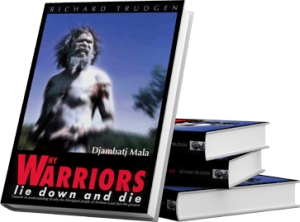Most societies across the world dress up for special occasions. Traditionally Aboriginal people never wore a lot of clothing and so their bodies became part of the dress up. Different paints, ochres and designs tell us a different story. The paint is part of the teaching information, the passing on information, and a part of the story. In some cases the body painting is very elaborate and it speaks to the ‘tartan’ of a particular tribe or clan. Or speaks to a particular thing that a young person is learning. In coming-of-age programs for young men for instance, when they’re painted in particular ways in particular designs, they enter into the knowledge of that design and the information that they’re learning around it. So it’s painted on their bodies as a way of enforcing that education process.
One non-Indigenous Australian said to a group of Yolŋu people, “it’s a very pagan act isn’t it? To paint your body?”. But they can respond that it’s a very pagan act for people to put tattoos all over themselves. For Yolŋu, the painting of the body is like putting on clothing, like putting on a uniform. And those who are the teachers at a particular ceremony, or those who are in charge of the ceremony, will put on different types of paint. So the paint is a form of dress for the different officers in charge at that particular function.
Rev. Dr. Djiniyini Gondarra OAM discusses this in relation to Yolŋu law and the Makarrata peace-making process when he refers to the uniform of the guards, or the djuŋgaya, Yolŋu police. There are three Makarrata processes, and in the Second Makarrata way, restorative justice is achieved between the victims of a crime and the criminal. In these cases, the political leaders (dalkarra djirrikay) from the families of the thief and from the victim’s family will control the legal process in a Makarr-garma, or a semi public arena. This arena will be in a Mukla Wäŋa, or legally safe place of the clan who are the victims. These safe places have legally protective symbols of that clan (such as the king brown snake or fire) that protect them so nobody can breach them. It also keeps other Yolŋu from interfering in the process, making it similar to old Scottish halls or embassies, protected by guards (the djuŋgaya, Yolŋu police).
The djuŋgaya, Yolŋu police are painted with okra that displays the emblems of that clan group. When they are “all painted up, they are dressed in an official uniform,” says Dr. Djiniyini. So “you won’t have Northern Territory police there, but you’ll have the right painting emblems to say that person is the djuŋgaya for that particular Bäpurru corporate clan group.” And this is similar to Northern Territory police uniforms that have their own symbols and ways of representing levels of authority.
Yolŋu police officers have also taken an oath just like Balanda policemen, in order to wear that uniform and keep the peace. They put up dilly bags (symbols of legal authority) in the safe place so people will see they can’t go in, and they also hold milak (weapons) to show they have authority to exert ‘reasonable force’ against any intruders if necessary. Just like a Balanda government or court that will defend against anyone who does not abide by its legal proceedings.
______________________
For more information on Yolŋu law and the Makarrata peace processes visit:
First Makarrata way
Second Makarrata way
Third Makarrata way
For more information on body paint in Yolŋu culture, listen to our Q&A no.74: “Why do Aboriginal people paint themselves up to perform traditional dances and ceremonies?”



